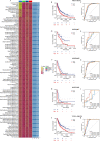Machine learning-derived identification of tumor-infiltrating immune cell-related signature for improving prognosis and immunotherapy responses in patients with skin cutaneous melanoma
- PMID: 37752452
- PMCID: PMC10521465
- DOI: 10.1186/s12935-023-03048-9
Machine learning-derived identification of tumor-infiltrating immune cell-related signature for improving prognosis and immunotherapy responses in patients with skin cutaneous melanoma
Abstract
Background: Immunoblockade therapy based on the PD-1 checkpoint has greatly improved the survival rate of patients with skin cutaneous melanoma (SKCM). However, existing anti-PD-1 therapeutic efficacy prediction markers often exhibit a poor situation of poor reliability in identifying potential beneficiary patients in clinical applications, and an ideal biomarker for precision medicine is urgently needed.
Methods: 10 multicenter cohorts including 4 SKCM cohorts and 6 immunotherapy cohorts were selected. Through the analysis of WGCNA, survival analysis, consensus clustering, we screened 36 prognostic genes. Then, ten machine learning algorithms were used to construct a machine learning-derived immune signature (MLDIS). Finally, the independent data sets (GSE22153, GSE54467, GSE59455, and in-house cohort) were used as the verification set, and the ROC index standard was used to evaluate the model.
Results: Based on computing framework, we found that patients with high MLDIS had poor overall survival and has good prediction performance in all cohorts and in-house cohort. It is worth noting that MLDIS performs better in each data set than almost all models which from 51 prognostic signatures for SKCM. Meanwhile, high MLDIS have a positive prognostic impact on patients treated with anti-PD-1 immunotherapy by driving changes in the level of infiltration of immune cells in the tumor microenvironment. Additionally, patients suffering from SKCM with high MLDIS were more sensitive to immunotherapy.
Conclusions: Our study identified that MLDIS could provide new insights into the prognosis of SKCM and predict the immunotherapy response in patients with SKCM.
Keywords: Immunotherapy; Machine learning; Skin cutaneous melanoma; Tumor microenvironment.
© 2023. The Author(s).
Conflict of interest statement
The authors declare that they have no competing interests.
Figures









Similar articles
-
Machine learning-derived identification of prognostic signature for improving prognosis and drug response in patients with ovarian cancer.J Cell Mol Med. 2024 Jan;28(1):e18021. doi: 10.1111/jcmm.18021. Epub 2023 Nov 23. J Cell Mol Med. 2024. PMID: 37994489 Free PMC article.
-
Development and validation of an immune gene set-based prognostic signature in cutaneous melanoma.Future Oncol. 2021 Nov;17(31):4115-4129. doi: 10.2217/fon-2021-0104. Epub 2021 Jul 22. Future Oncol. 2021. PMID: 34291650
-
Machine learning-based identification of an immunotherapy-related signature to enhance outcomes and immunotherapy responses in melanoma.Front Immunol. 2024 Sep 17;15:1451103. doi: 10.3389/fimmu.2024.1451103. eCollection 2024. Front Immunol. 2024. PMID: 39355255 Free PMC article.
-
The Landscape of the Tumor Microenvironment in Skin Cutaneous Melanoma Reveals a Prognostic and Immunotherapeutically Relevant Gene Signature.Front Cell Dev Biol. 2021 Oct 1;9:739594. doi: 10.3389/fcell.2021.739594. eCollection 2021. Front Cell Dev Biol. 2021. PMID: 34660598 Free PMC article.
-
Machine learning developed an intratumor heterogeneity signature for predicting prognosis and immunotherapy benefits in skin cutaneous melanoma.Melanoma Res. 2024 Jun 1;34(3):215-224. doi: 10.1097/CMR.0000000000000957. Epub 2024 Feb 16. Melanoma Res. 2024. PMID: 38364052
Cited by
-
Machine learning models for predicting of PD-1 treatment efficacy in Pan-cancer patients based on routine hematologic and biochemical parameters.Cancer Cell Int. 2024 Jul 21;24(1):258. doi: 10.1186/s12935-024-03439-6. Cancer Cell Int. 2024. PMID: 39034386 Free PMC article.
-
Identification of CNKSR1 as a biomarker for "cold" tumor microenvironment in lung adenocarcinoma: An integrative analysis based on a novel workflow.Heliyon. 2024 Apr 4;10(8):e29126. doi: 10.1016/j.heliyon.2024.e29126. eCollection 2024 Apr 30. Heliyon. 2024. PMID: 38628722 Free PMC article.
-
Numb and NumbL inhibit melanoma tumor growth by influencing the immune microenvironment.BMC Cancer. 2024 Nov 18;24(1):1419. doi: 10.1186/s12885-024-13191-9. BMC Cancer. 2024. PMID: 39558287 Free PMC article.
References
-
- Garbe C, Amaral T, Peris K, Hauschild A, Arenberger P, Basset-Seguin N, Bastholt L, Bataille V, Del Marmol V, Dréno B, et al. European consensus-based interdisciplinary guideline for melanoma. Part 2: treatment—update 2022. Eur J Cancer (Oxford, England: 1990) 2022;170:256–284. doi: 10.1016/j.ejca.2022.04.018. - DOI - PubMed
LinkOut - more resources
Full Text Sources

